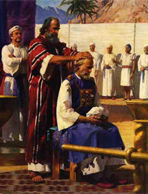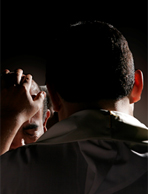 Priesthood Priesthood
Structure and Authority
Catholic Doctrine
The Catechism defines the priesthood of Christ as the following:
“The unique high priest, according to the Order of Melchizedek.
Christ fulfilled everything that the priesthood of the Old
Covenant prefigured. (cf. Heb 5:10, 6:20). He offered himself once
and for all (Heb 10:14), in a perfect sacrifice upon the cross.
His priesthood is made present in a special way in the Church
through the ministerial priesthood, conferred through the
Sacrament of Holy Orders” (Catechism glossary).
The priesthood is the power to act for Christ in his person, given
to his Apostles and their successors. The priesthood was on earth
before the coming of Christ. The priesthood of the Old Covenant
was called the Aaronic Priesthood and was established to
administer in the ordinances of the Old Testament and to prepare
man for the priesthood and ministry of the New Covenant, the
Melchizedek Priesthood. The Aaronic Priesthood lacked the power to
bring about salvation and therefore was fulfilled in Christ Jesus
in the Melchizedek priesthood as part of God’s New Covenant with
man.
“Melchizedek” is the “king of Salem [who] brought forth bread and
wine: and he was the priest of the most high God” (Gen. 14:18).
Psalm 110:4 says “…Thou art a priest for ever after the order of
Melchizedek.” This is echoed by Paul in his letter to the Hebrews
when he refers to Christ as the “high priest after the order of
Melchisedec” (Heb. 5:10).
Priests in the Catholic Church are ordained through the sacrament
of Holy Orders, which is bestowed (or conferred) by the laying on
of hands by a bishop, followed by a prayer in which God is
petitioned to provide the graces of the Holy Spirit to the
ordained. Holy Orders can only be conferred upon baptized men who
have been recognized by Catholic authority as suitable for the
ministry.
The priesthood of the Catholic Church is granted and practiced in
three degrees: bishops, priests (or presbyters), and deacons. Each
of the three degrees has distinct responsibilities and authority
within the ministry, with only bishops and priests holding the
priesthood:
BISHOPS:
“The bishop receives the fullness of the sacrament
of Holy Orders, which integrates him into the Episcopal college
and makes him the visible head of the particular Church entrusted
to him. As successors of the apostles and members of the college,
the bishops share in the apostolic responsibility and mission of
the whole Church under the authority of the Pope, successor of St.
Peter” (Catechism 1594).
PRIESTS (or presbyters):
“Priests are united with the
bishops in sacerdotal dignity and at the same time depend on them
in the exercise of their pastoral functions; they are called to be
the bishops' prudent co-workers. They form around their bishop the
presbyterium which bears responsibility with him for the
particular Church. They receive from the bishop the charge of a
parish community or a determinate ecclesial office” (Catechism
1595).
DEACONS:
“Deacons are ministers ordained for tasks of
service of the Church; they do not receive the ministerial
priesthood, but ordination confers on them important functions in
the ministry of the word, divine worship, pastoral governance, and
the service of charity, tasks which they must carry out under the
pastoral authority of their bishop” (Catechism 1596).
Although only a small percentage of Catholic men hold the
priesthood, all baptized and faithful members of the Catholic
Church are able to share in the priesthood through the “common
priesthood of the faithful” (Catechism 1591). The first form of
the priesthood—the ministerial priesthood—is granted only to men
who have completed Holy Orders and been given the sacred duty to
dedicate their lives to service within the Catholic Church. The
second form, the common priesthood of the faithful, does not
involve the taking of vows or the dedication of one’s life to
service within the Church. However, all who share in the “common
priesthood of the faithful” are able to minister in a spiritual
sense through the Holy Spirit to the Catholic community.
The academic requirements to become a Catholic priest generally
include an undergraduate degree, including courses in philosophy
and psychology, followed by an additional four years minimum of
master’s related courses on ministry, divine studies, and
administration.
See Catechism 935, 1541, 1544, 1591 to 1598, 1600, and glossary.
Latter-day Saint
Doctrine
The Church of Jesus Christ of Latter-day Saints defines the
priesthood as “the power and authority of God” (Gospel
Principles, 81). It was by the power of the priesthood that
the heavens and earth were created and the universe is maintained
in its perfect order. Through the power of the priesthood, the
Lord achieves his ultimate mission “to bring to pass the
immortality and eternal life of man” (Moses 1:39).
There was a priesthood of God before, during, and after the
ministry of Jesus Christ. When Christ was upon the earth, he
ordained Apostles to lead his Church and “gave them the power and
authority of the priesthood to act in his name” (Mark 3:13-15;
John 15:16; Gospel Principles 81).
Priesthood authority is required to perform the ordinances such as
baptism, confirmation, the blessing and passing of the sacrament,
administering to the sick, performing special blessings, and the
administration of temple ordinances.
The priesthood is divided into the Aaronic Priesthood (the lesser
priesthood) and the Melchizedek Priesthood (the greater
priesthood). The Aaronic Priesthood is sometimes referred to as
the “preparatory priesthood.”
Aaronic Priesthood
The Aaronic Priesthood originated in the time of Moses and was
conferred upon Aaron and his sons to administer in the
ecclesiastical duties of God (Num. 18:1). Today, Aaronic
Priesthood holders administer the outward ordinances of repentance
and baptism (D&C 107:13–14, D&C 107:20).
The offices within the Aaronic Priesthood today include deacon,
teacher, priest, and bishop. Within a ward, the Aaronic Priesthood
is organized into a deacon’s quorum, a teacher’s quorum, and a
priest quorum.
DEACON:
Deacons perform duties such as passing the
sacrament, ushering during Sunday services or special occasions,
helping to maintain and clean Church buildings and grounds,
assisting priesthood leaders, and fulfilling special Church
assignments such as the collection of fast offerings.
TEACHER:
In addition to the duties of a deacon, teachers
take an active role in helping Church members live the
commandments, including home teaching. Teachers are also tasked
with the preparation of the bread and water for the sacrament.
PRIEST:
In addition to the duties of a deacon and teacher,
priests may baptize members, bless the bread and water of the
sacrament, and actively preach the gospel. A priest, in
preparation for the Melchizedek Priesthood, may ordain deacons,
teachers, and other priests. If there are no Melchizedek
Priesthood holders available, a priest may officiate at Church
meetings.
BISHOP:
A bishop holds the Melchizedek Priesthood in the
office of a high priest and presides over the Aaronic Priesthood
within the ward he is assigned—specifically as the president of
the priest’s quorum. The bishop is the leader and presides over
the entire ward and is responsible for the spiritual well-being of
every individual who lives within the geographic boundaries of his
ward—regardless of their religious affiliation. Bishops are given
the gift of discernment in order to act in their stewardship as
the Common Judge in Israel.
Melchizedek Priesthood
Melchizedek Priesthood holders are given the power and authority
to lead the spiritual work of the church, including the preaching
of the gospel and the administration of the ordinances within
temples. The President of the Church of Jesus Christ of Latter-day
Saints is the presiding high priest over the world-wide
Melchizedek Priesthood.
The offices within the Melchizedek Priesthood include elder, high
priest, patriarch, seventy, and Apostle. Within a ward, the
Melchizedek Priesthood is organized into an elders quorum and a
high priest group. The high priest group is part of a stake-wide
high priest quorum presided over by the stake president.
ELDER:
Each Melchizedek Priesthood holder can be referred
to as an elder, and all elders are called to “teach, expound,
exhort, baptize, and watch over the Church” (Gospel Principles,
90). Elders can lead or participate in the ordinance of
confirmation in which the gift of the Holy Ghost is bestowed by
laying on of hands. Elders can administer to the sick, bless
children of record, and preside at Church meetings as appropriate
in the absence of a high priest.
HIGH PRIEST:
A high priest is a Melchizedek Priesthood
holder who is put in charge of the spiritual affairs of a
particular entity or geographic area. Members of bishoprics, stake
presidencies, mission presidencies, high councilors, and other
selected leaders of the church must be ordained high priests. A
high priest retains all of the spiritual privileges of an elder.
PATRIARCH:
A patriarch is called to give special blessings
to the Church. “patriarchal blessings” provide guidance and
insight to those who receive them.
SEVENTY:
Seventies are General Authorities of the Church
who are called as “special witnesses” of Jesus Christ to the
entire world and help administer in the affairs of the Church. At
the time of this writing there are eight quorums of seventies that
currently serve within the Church of Jesus Christ of Latter-day
Saints.
APOSTLE:
Like the seventies, Apostles are also special
witnesses of Jesus Christ to the world and administer in the
affairs of the Church as prophets, seers, and revelators. There
are Twelve Apostles and together they form the Quorum of the
Twelve Apostles; however, members of the first presidency may also
be set apart as members of the Quorum of the Twelve Apostles.
Apostles are given all of the keys of the kingdom of God on earth,
but only the President of the Church “actively exercises all of
the keys…the others act under his direction” (Gospel Principles,
91).
The priesthood is available to all worthy male members of the
Church. It is granted “by the laying on of hands by those who are
in authority, to preach the Gospel and administer in the
ordinances thereof” (Articles of Faith 1:5).
There are no academic or professional requirements to hold the
priesthood, nor are there any such requirements to hold any
leadership position within the Church of Jesus Christ of
Latter-day Saints. However, readiness for any leadership calling
takes into account reliable evidence of such readiness, and this
evidence can include educational and professional achievements.
See Gospel Principles, 81 to 91 and 238.
See chapter 9 in Catholic Roots, Mormon
Harvest for a more comprehensive explanation and commentary on
priesthood structure and authority.
 Priesthood Power –
Healings and Blessings Priesthood Power –
Healings and Blessings
Catholic Doctrine
Anointing of the sick is one of the Seven
Sacraments, sometimes called the “sacrament of the dying.” It is
administered to a baptized individual who is in danger of death.
The Church has designated that the most appropriate time for an
individual to receive this sacrament is when the person is near
death, even if the person had previously received an anointing and
the sickness has merely become worse.
The purpose of the anointing is to provide “special grace of
healing and comfort to the Christian who is suffering the
infirmities of serious illness or old age, and the forgiving of
the person’s sins” (Catechism 1528).
The anointing of the sick can take place anywhere (home, hospital,
battlefield, etc.) and should only be performed by a bishop or
priest. The ordinance calls for the priest or bishop to lay hands
upon the inflicted, to pray over them, and then to anoint the
individual with oil that has been blessed by the bishop.
In the gravest of circumstances, under the inspiration of the
authorized Catholic minister, there are conditional provisions for
the anointing of the sick to be given to Christians who are not in
full standing with the Catholic Church, if it is the person’s
desire to be anointed.
Catholic doctrine calls for the Church to rely upon the power of
the Holy Spirit to continue the work of Jesus Christ, the great
physician, in healing the members of his Church. The sacraments of
Penance and the Anointing of the Sick have the express purpose of
healing the faithful Christian by the power of priesthood.
There is no Catholic doctrine authorizing blessing and anointing
those who are not gravely ill or injured.
See Catechism 1401, 1421, 1517, 1519, 1527 to 1530, and glossary.
Latter-day Saint Doctrine
Latter-day Saint doctrine on healing holds the
premise that healing comes as a result of faith. Therefore,
administering to the sick is always preceded by a request for the
blessing by the person in need or an individual close to that
person (parent, sibling, or other). In doing so the healing comes
as an answer to exercised faith (Matt. 8:5-15).
As the power of God on earth, the priesthood has the authority and
power to heal and bless the faithful. While those who hold the
Melchizedek Priesthood are given the power to anoint the sick and
perform blessings, there are some priesthood holders who are given
the gift of healing the sick, a gift of the spirit. In all cases,
holders of the priesthood are admonished to use their priesthood
“by persuasion, by long-suffering, by gentleness and meekness, and
by love unfeigned” (D&C 121:41).
The power to bless can come in the form of anointing the sick (in
whatever state they may be) or to provide a blessing of guidance
and comfort to an individual. The individual need not be gravely
ill, but they must have faith that the Lord Jesus Christ (or a
parent/individual acting on faith in their behalf), acting through
the priesthood, will heal them of their infirmity. Among the
ordinances that include blessings that can take place through the
priesthood are blessings of children; of comfort and/or guidance;
and of healing. There are blessings that take place during the
ordinance of confirmation and those that take place when
individuals are set apart in callings. There are also patriarchal
blessings that provide guidance and encouragement, blessings of
homes, and dedication of graves.
Priesthood blessings for healing typically begin with one
priesthood holder anointing the head of the afflicted with
consecrated oil. (Oil is consecrated by Melchizedek Priesthood
holders in a separate ordinance.) After the anointing, the
priesthood holder places his hands on the head of the afflicted,
calls the person by his or her full name, states the authority of
the priesthood, recites a simple prayer regarding the anointing,
and closes in the name of Jesus Christ. This is all done audibly,
not in silence.
A second Melchizedek Priesthood holder then places his hands with
those of the first on the person’s head and seals the anointing:
He pronounces a blessing as dictated by the Holy Ghost, and then
closes in the name of Jesus Christ. This too is done audibly. In
an emergency, a single Melchizedek Priesthood holder can both
anoint and seal.
A blessing of comfort is performed by a Melchizedek Priesthood
holder laying his hands upon the head of the desiring individual,
calling the person by his or her full name, stating the authority
of the priesthood, providing a blessing as dictated by the Holy
Ghost, and then closing in the name of Jesus Christ.
A priesthood holder should be in a state of worthiness when
performing a blessing, performing each blessing in a reverent and
dignified manner, realizing at all times that he is acting on
behalf of the Savior Jesus Christ. In some cases a group of
Melchizedek priesthood holders may perform the blessing. This is
typically done with each priesthood holder having his left hand on
the head of the individual being blessed and his right hand on the
shoulder of the priesthood holder next to him, all forming a
circle around the individual.
See Gospel Principles, 83 and 147; Mormon Doctrine,
22 and 345; and “Duties and Blessings of the Priesthood”, Part B,
Priesthood and Church Government, 5: Performing Priesthood
Ordinances, 41.
See chapter 9 in Catholic Roots, Mormon Harvest
for a more comprehensive explanation and commentary on priesthood
power
 Priesthood Marriage and Celibacy Priesthood Marriage and Celibacy
Catholic Doctrine
The Catholic doctrine on celibacy in the
priesthood is historical, generally well known, and clearly
defined: “In the Latin Church the sacrament of Holy Orders for the
presbyterate is normally conferred only on candidates who are
ready to embrace celibacy freely and who publicly manifest their
intention of staying celibate for the love of God's kingdom and
the service of men” (Catechism 1599).
Celibacy is defined in the Catechism as “the state or condition of
those who have chosen to remain unmarried for the sake of the
kingdom of heaven in order to give themselves entirely to God and
to the service of his people” (Catechism glossary). Curiously, the
definition of celibacy refers to marriage only, not to sex.
Celibacy is highly celebrated in the Catholic Church as a means of
proclaiming the “Reign of God” and consecrating one’s self to God
and to the Church.
See Catechism 1579, 1599, and glossary.
Latter-day Saint
Doctrine
Both married and unmarried men are permitted to
hold the priesthood in the Church of Jesus Christ of Latter-day
Saints. Like all members of the Church, priesthood holders must
live the law of chastity, which states: “We are to have sexual
relations only with our spouse to whom we are legally married. No
one, male or female, is to have sexual relations before marriage.
After marriage, sexual relations are permitted only with a spouse”
(Gospel Principles, 249).
See chapter 9 in Catholic Roots, Mormon Harvest
for a more comprehensive explanation and commentary on priesthood
marriage and celibacy.
 Paid Ministry Paid Ministry
Catholic Doctrine
We were unable to locate an official statement
or doctrine concerning monetary compensation given to priests and
others who minister in the Catholic Church. A passage from the
Catechism of the Catholic Church suggests that one should not
pursue wages in doing good (perhaps referring to the ministry),
implying that wages should not be the reason that one would enter
into the ministry: “The practice of the moral life animated by
charity gives to the Christian the spiritual freedom of the
children of God. He no longer stands before God as a slave, in
servile fear, or as a mercenary looking for wages, but as a son
responding to the love of him who "first loved us": If we turn
away from evil out of fear of punishment, we are in the position
of slaves. If we pursue the enticement of wages, . . . we resemble
mercenaries. Finally if we obey for the sake of the good itself
and out of love for him who commands . . . we are in the position
of children” (Catechism 1828).
The Catholic priesthood is listed as a career in the 1998-99
Occupational Handbook, citing “…the shortage of Roman Catholic
priests is expected to continue, resulting in a very favorable job
outlook through the year 2006.” According to William P. Daly,
Director of Research for the National Association of Church
Personnel Administrators (NACPA), the median salary received by
priests increased from $12,222 in 1966 to $15,483 in 1999 to
$16,885 for 2001/02. During the same time period priests' median
total taxable income and support likewise increased from $26,569
to $33,059. Priests can also be paid stipends for such services as
marriages and other ceremonies.
In 1992 the average salary for full time lay ministers (not
priests or nuns) was $13,000 to $20,000 per year, increasing by
15-37 percent between 1992 and 1997.
Latter-day Saint Doctrine
Church of Jesus Christ of Latter-day Saints,
like the Catholic Church, has no specific doctrine or official
statement on wages or salary of priesthood holders. However, it is
well known that with the exception of selected worldwide Church
leaders who are offered (and who often do not accept) a small
stipend, the Church has an all volunteer unpaid lay ministry. This
means that bishops, stake presidents, and other priesthood holders
retain their professional careers and do not receive Church
compensation of any kind to serve in their respective priesthood
callings.
Elder Boyd K Packer of the Quorum of the Twelve Apostles had this
to say about this unpaid ministry: “In the Church of Jesus Christ
of Latter-day Saints there is no paid ministry, no professional
clergy, as is common in other churches. More significant even than
this is that there is no laity, no lay membership as such; men are
eligible to hold the priesthood and to carry on the ministry of
the Church, and both men and women serve in many auxiliary
capacities. This responsibility comes to men whether they are rich
or poor, and with this responsibility also comes the authority.
There are many who would deny, and others who would disregard it;
nevertheless, the measure of that authority does not depend on
whether men sustain that authority, but rather depends on whether
God will recognize and honor that authority” (Boyd K. Packer,
“Follow the Brethren,” Tambuli, Sept. 1979, 53).
Elder Derek A. Cuthbert of the Seventy said: “Over the years of my
membership in The Church of Jesus Christ of Latter-day Saints, I
have greatly appreciated the opportunities for service, for there
is no paid ministry. Every worthy male member of the Church above
the age of twelve may hold an office in the priesthood. Similarly,
the girls and women of the Church receive many assignments to lead
and teach and serve. Each family is visited monthly by priesthood
home teachers, who care for their needs, and by visiting teachers
from the women’s Relief Society, whose motto is ‘charity never
faileth’” (Elder Derek A. Cuthbert, “What’s the Difference?”
Ensign, Nov. 1985, 24).
See chapter 9 in Catholic Roots, Mormon Harvest
for a more comprehensive explanation and commentary on a paid
ministry. |